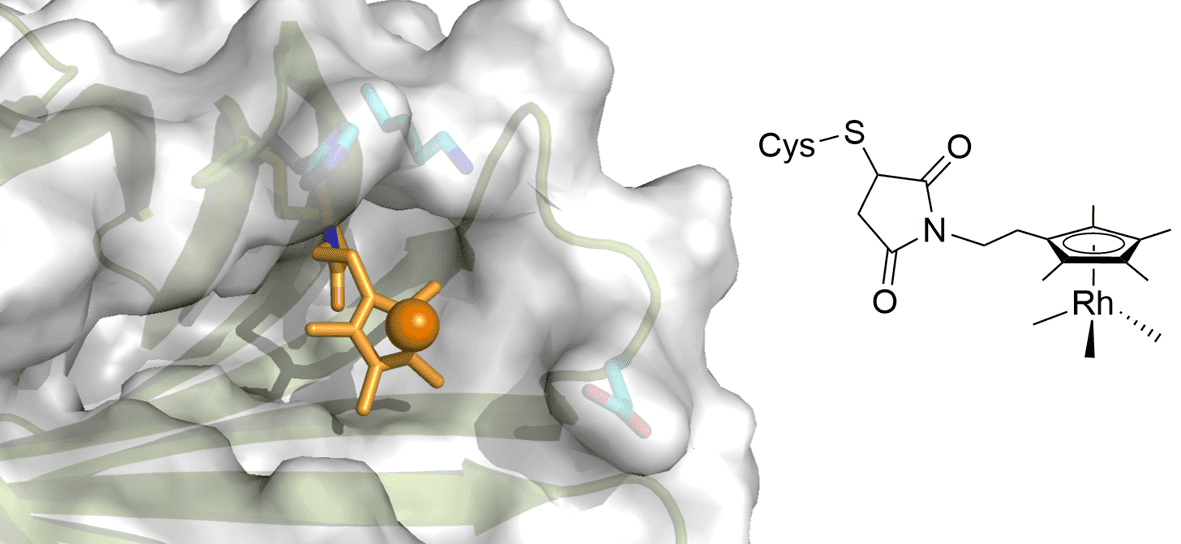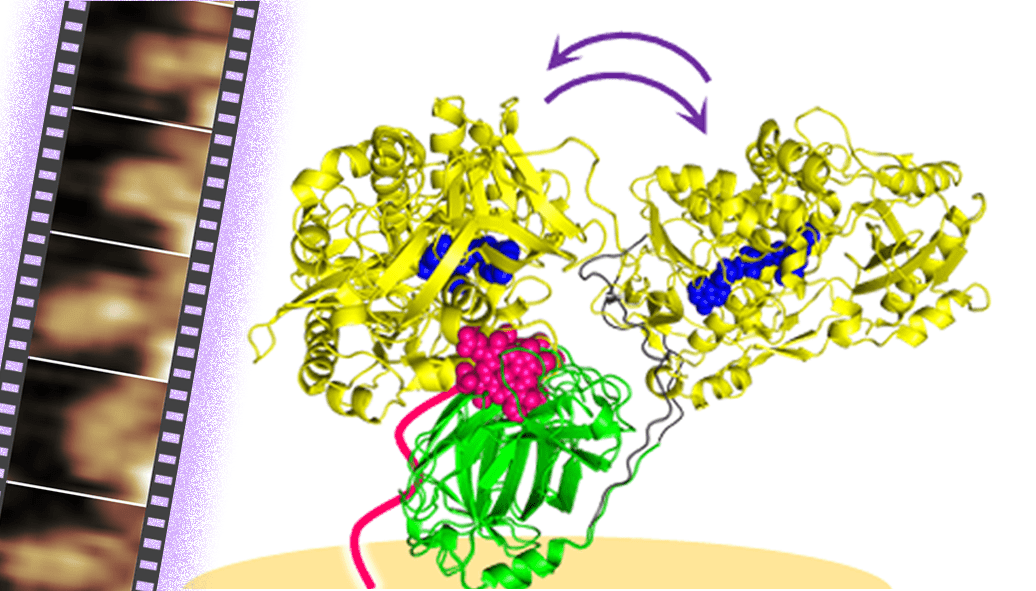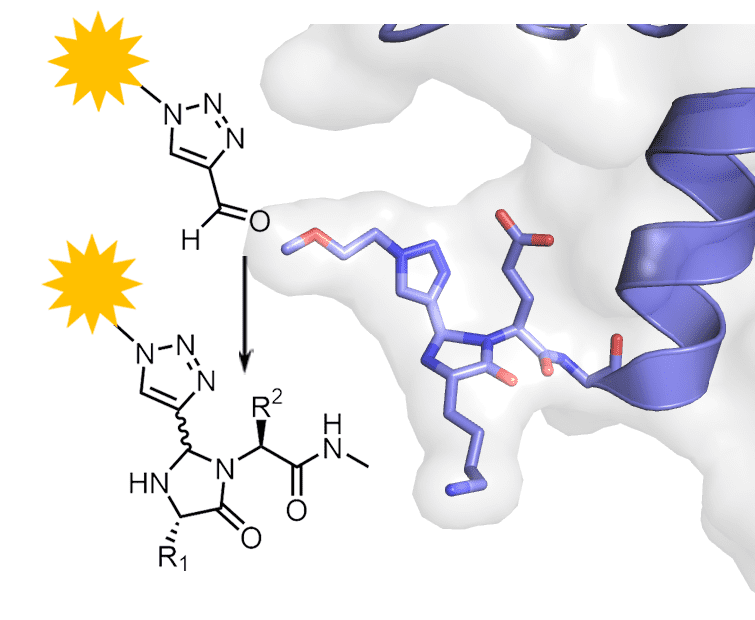
RESEARCH

RESEARCH
Objective
人類、地球、繁栄のための行動計画として、持続可能な開発目標(SDGs)が掲げられ、世界全体がこの目標に向っています。そのための重要なターゲットの一つが、タンパク質です。生物が生み出すタンパク質は、生物を構成する材料であり、すべての生物由来の材料を作り出し、様々な物質変換を行う酵素でもあります。したがって、材料や触媒としてのタンパク質の機能をより効率的に利用する技術が求められています。私たちは、化学とタンパク質工学の技術を組み合わせて、非天然の物質変換を実現するバイオ触媒、タンパク質の機能を利用したバイオ材料やバイオデバイスの創製に取り組んでいます。そのために、タンパク質に化学修飾より機能する手法、非天然の金属錯体を組み込んだ指向性進化工学の手法など、タンパク質の機能を利用する新しいバイオテクノロジーや技術を開発しています。有機化学、錯体化学、タンパク質工学、材料科学を礎として、循環型社会と地球環境保全に向けた新しいケミストリーとサイエンスを開拓しています。
Proteins are materials that constitute and shape living systems, and they produce and transform molecules as enzymes. There is thus increasing demand on technology utilizing protein function as catalysts and materials to pursue sustainable developmental growth. We develop engineered biocatalysts undergo abiotic reactions, and biomaterials and biodevices implementing protein function. To access these targets, our research also focuses on new chemical modification methods and technology platforms for directed evolution of proteins.
Biocatalyst
酵素は、進化の過程を経て、機能を極限まで磨き上げた触媒です。最適化された反応場によって、様々な条件下で反応が円滑に進行し、高い基質・立体選択性を達成しています。一方、金属錯体の触媒は、配位子の精密設計によって C−C 結合生成などの多様な化学反応の開拓と選択性の向上がなされています。私たちは、循環型の物質変換を指向して、タンパク質が作り出す反応場と金属錯体触媒が有する多彩な反応性を融合した新しいバイオ触媒としてバイオハイブリッド触媒を開発しています。化学合成と微生物発酵による物質変換を融合する技術へ展開し、バイオマスから有用物質群へ変換する技術への応用を目指しています。
Enzymes are excellent catalysts that have been evolved to provide suitable chemical environment through billions years of natural selection. Chemists have been developed a wide range of synthetic catalysts that proceed abiotic reactions, which have been used to provide materials and pharmaceuticals. To explore catalysts for abiotic reactions that enable unexplored regioselectivity and chemoselectivity, we complement a reactive synthetic metal catalyst and a protein scaffold generating a biohybrid catalysts, in other words artificial metalloenzymes. Along this direction, our focus also lies on new synthetic methods complementing chemical synthesis and biosynthesis that will be applicable for the use of biomass.

Biomaterials and Biodevices
タンパク質や酵素が発現する電子移動、触媒、センサーなどの機能を材料と融合して利用することによって、バイオ材料やバイオデバイスとして応用することができます。この目的のために、タンパク質の位置を選択的に材料表面と連結することによって、タンパク質や酵素の機能を損なうことなく利用するための基盤技術を開発しています。この技術により、例えば効率的な電子移動を可能にするバイオデバイスを構築することができます。また、酵素を材料表面に固定化する技術を深化させて、動的構造変化と機能解明にも取り組んでいます。高速AFM を活用し、タンパク質が触媒反応を行っている様子を直接観察し、連動したドメイン間の動きを捉えることにも成功しています。酵素機能の本質を明らかにし、バイオ材料とバイオデバイスへの応用を追及します。
Functions of enzymes such as electron transfer, catalysis, and sensor can be utilized by combining with materials as biomaterials and biodevices. Technology immobilizing enzymes on the surface of materials is thus a key to maximize the function of enzymes of focus. We are now developing rationale and simple methods to immobilize enzymes without disturbing their motions essential for functioning, and to visualize the motions of enzymes in parallel. These knowledge and technology are now utilized to construct biomaterials and biodevieces in our group.

Protein Engineering & Biomedical Applications
タンパク質は、遺伝情報に基づき転写、翻訳を経て、多様な構造と機能をもち、翻訳後修飾により、さらに複雑な機能を獲得します。私たちは、有機化学を活用して、簡便に、かつ狙った通りの位置で化学修飾を施すタンパク質修飾技術を開発しています。機能性の分子を自在に導入したテーラーメイドタンパク質を作製することができます。また、タンパク質のアミノ酸変異をランダムに施して、狙った機能が向上した変異体を、効率的に得ることができる進化工学の技術も開発しています。テーラーメイドタンパク質を自在につくる技術を開拓し、機能性材料、医療材料、触媒材料として医療や環境応用へ展開しています。
Proteins has a diverse array of structures and function on the basis of 20 amino acids, and living systems extends the diversity of chemical entities of proteins by covalent modification to polypeptide chains. This is termed as post-translational modification. We are now developing new methods enabling site-specific chemical modification of proteins and tethering several functional molecules including dyes, synthetic polymers, and drugs. In addition, directed evolution using laboratory selection is a powerful technology for improving the function of proteins or enzymes. We are also seeking the useful technology platform for directed evolution. With the combination of these technologies, we construct tailor-made proteins useful for biomaterials in the application of environmental science and medicine.

Carbon Catalysts
石油に代わる燃料の候補となるのが水素です。その水素で駆動する自動車は、燃料電池車として利用が広がっています。この燃料電池のカソード極には、高価な白金触媒が利用されていますが、非貴金属を使った触媒への移行が探索されており、その一つが非貴金属カーボン触媒です。カーボン材料は、石油だけでなく、バイオマスなどの生体材料からも生産が可能な機能性材料であり、私たちはタンパク質を焼成して調製できる触媒づくりから研究に取り掛かりました。現在は、有機合成と錯体化学の見地から、精密で高活性な金属活性点をつくりだし、新たな非貴金属カーボン触媒の開発に取り組んでいます。
Hydrogen is considered as an alternative for fossil fuel, and polymer electrolyte fuel cells is one of the most promising sustainable energy conversion technology. Electrochemical oxygen reduction reaction (ORR) is a key reaction for this purpose. To replace platinum, non-precious metal-based catalysts have been attracted great attention. We initiated our investigation using proteins as source of carbon catalysts, and shift our target to a Fe/N/C catalyst prepared by pyrolysis of iron, nitrogen, and carbon containing precursors. The requisites for the development of the highly active Fe/N/C catalysts include precise construction and characterization of the active site structures. We are thus developing thermally controlled construction of the active sites in the Fe/N/C catalysts by applying bottom-up synthetic methodology for precursors.


